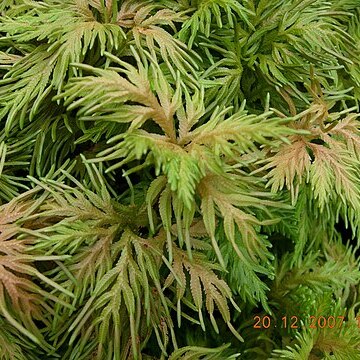Plants on rock or terrestrial, forming long or spreading mats or rarely cushionlike mats. Stems radially symmetric, long to moderately short-creeping to decumbent, not readily fragmenting, irregularly forked, without budlike arrested branches, tips straight; main stem indeterminate, lateral branches conspicuously or inconspicuously determinate, sometimes ascending, 1--3-forked. Rhizophores borne on upperside of stems, throughout stem length, 0.25--0.45 mm diam. Leaves monomorphic, in alternate pseudowhorls of 6 (on main stem) to 4 (on lateral branches), tightly appressed, ascending, green, occasionally reddish, linear or linear-lanceolate, 2.5--4(--4.5) X 0.45--0.6 mm; abaxial ridges well defined; base cuneate and decurrent on underside to rounded and adnate on upperside, pubescent or glabrous; margins long-ciliate, cilia transparent, spreading, (0.05--)0.07--0.17 mm; apex slightly keeled, mostly attenuate; bristle white, whitish, or transparent, puberulent, 0.45--1(--1.5) mm. Strobili solitary, 0.5--3.5 cm; sporophylls deltate-ovate to ovate-lanceolate, strongly tapering or not toward apex, abaxial ridges well defined, base glabrous, margins ciliate to slightly dentate, apex slightly keeled, not truncate in profile, long-bristled. 2 n = 18.
More
Stems much branched and with numerous rhizophores, 1 mm thick (excl. lvs), the creeping and the erect (to 6 cm) branches similar except that the latter terminate in tetragonous cones 1–1.5 cm × 1 mm; lvs spirally arranged, appressed, thick and firm, subulate, ciliolate, 1.5–2 × 0.25–4 mm, tipped by a scabrous slender white bristle 1–1.5 mm; sporophylls 4-ranked, evidently broader than the lvs; megaspores yellowish, 0.5 mm wide, faintly reticulate or rugose on all faces, often only 1 or 2 per sporangium, and the plants then usually apogamous and lacking microsporangia; 2n=18. Rocky or sandy, mostly acid soil; s. Greenl. to ne. Alta., s. to n. Ga. and Okla

